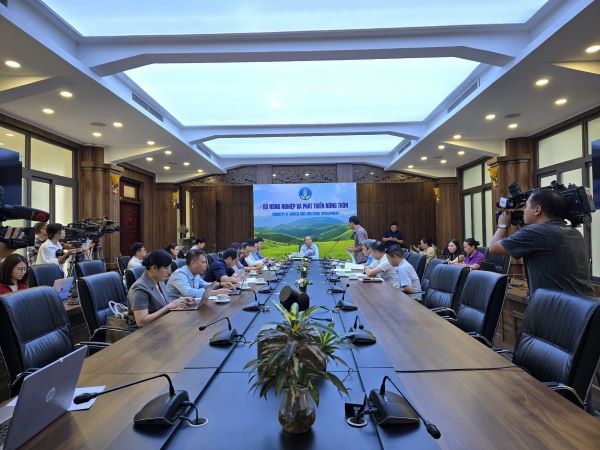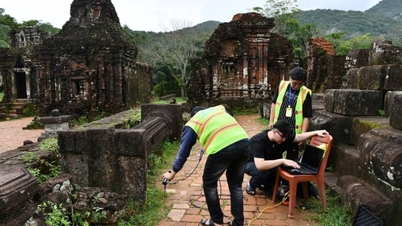Chairing the press conference, Deputy Minister Phung Duc Tien said that, implementing the Prime Minister 's direction on the three stages of forecasting, prevention and recovery, at this time it is necessary to immediately deploy work to overcome the consequences of storm No. 3, promptly handle issues related to people's lives, production, business, response to landslides, subsidence...
According to the Department of Dyke Management and Natural Disaster Prevention, storm No. 3 has caused huge property damage. In addition to strong winds, storm No. 3 caused widespread heavy rain from 200-400mm, especially heavy rain in Lao Cai, Son La with rainfall up to 600mm, Thai Nguyen 550, Cao Bang over 500mm, etc. As of 1:30 p.m. on September 9, 2024, there were 59 people dead or missing, of which 09 people were due to the storm; 44 people were due to landslides and flash floods; 06 people were swept away by floods; not including the number of people who died in the collapse of Phong Chau bridge, Phu Tho; the number of injured people was 251 people and 25 ships and boats of all kinds sank at the anchorage in Quang Ninh.
Preliminary damage to agricultural production included 124,593 hectares of rice and 22,047 hectares of crops flooded and damaged; 6,887 hectares of fruit trees damaged; over 1,500 aquaculture cages damaged and swept away (concentrated in Quang Ninh with 1,000 cages); nearly 100 livestock and 200 poultry died (concentrated in Hai Duong with 186,000 poultry).
Scene of the press conference
Immediately after the meeting to assess the preliminary damage of storm No. 3 on the morning of September 9, the Ministry directed the Department of Irrigation, Crop Production, Livestock, and Veterinary Medicine to draft a document guiding localities on specific measures to overcome the consequences of the storm, and soon restore production and the lives of people in provinces directly affected by the storm.
Accordingly, the Department of Irrigation has issued two telegrams directing the Department of Agriculture and Rural Development of the provinces to implement and ensure the safety of dams and reservoirs. After the storm, reservoirs in the northern region were basically over 90% full. Flood control work was carried out under the direction of the Prime Minister and the Ministry. Before the storm, localities had drained water from the fields. After the storm, 85,000 hectares of rice and vegetables were still flooded. The Department of Irrigation is directing localities to operate the maximum irrigation systems that can drain water. It is expected to be completed in the next two days to try to keep the flooded area.
Director of the Department of Crop Production Nguyen Nhu Cuong acknowledged that although it was a strong storm, the Red River Delta alone had a rice area of about 50-60 thousand square meters that was affected by the circulation during and after the storm with not much rainfall. The actual rice area affected by the storm was not large, the rice area that could not be restored was low, if there were no changes, the production of the Summer-Autumn crop in the Red River Delta would be protected. The midland and mountainous provinces in the North with a rice area of about 410 thousand hectares were not greatly affected, however, due to the mountainous terrain, the circulation after the storm often lasted for a long time, causing a great risk of landslides, preventing drainage.
Before the storm hit, the Department of Crop Production sent a document to localities guiding pre-storm solutions for rice, vegetables, and fruit trees such as buffer drainage, and coordinated with the Department of Irrigation to help localities drain water thoroughly. On the morning of September 9, the Department of Crop Production submitted to the Deputy Minister for signature and issued a document guiding localities on post-storm solutions for each main crop: rice, vegetables, and fruit trees, including bananas and citrus trees, which are important fruits, especially for the Tet market. People should note that after a heavy rain like the recent one, some pests and diseases will emerge, such as leaf blight. For bad rice fields that cannot be harvested, the Department of Crop Production also provided instructions on immediate technical treatment to plant early winter crops.
Mr. Tran Dinh Luan, Director of the Department of Fisheries, said that in addition to the number of fishing vessels that were sunk or temporarily sunk, there were also a number of small vessels in the anchorage area to avoid the storm. Although there had been good preparation before the storm hit, such as instructing fishermen to exploit aquatic species that were large enough, requiring ships to anchor cages for those whose output was not enough to exploit, due to the big storm, the aquaculture industry in Quang Ninh and Hai Phong still suffered heavy losses.
Currently, the Ministry has directed localities to take care of the remaining fish to continue to maintain. For dead fish, broken cage frames, and buoys that are affecting the environment, the Department of Fisheries requires localities to collect them and bring them ashore. Learning from this storm, the Department hopes that localities will change the materials used to make cages and rafts to flexible materials that can withstand wind and waves to minimize damage.
The good news is that after the storm inspection at the anchorage, the fishermen are ready to return to sea in the next 2-3 days. The leaders of the Department of Fisheries also hope that in the long term, in the strategy of marine farming, efforts to change occupations, and develop marine farming, the Ministry will encourage fishermen not to be discouraged, continue to improve to exploit the potential of marine farming better.




![[Photo] General Secretary To Lam receives the Director of the Academy of Public Administration and National Economy under the President of the Russian Federation](/_next/image?url=https%3A%2F%2Fvphoto.vietnam.vn%2Fthumb%2F1200x675%2Fvietnam%2Fresource%2FIMAGE%2F2025%2F12%2F08%2F1765200203892_a1-bnd-0933-4198-jpg.webp&w=3840&q=75)

































































































Comment (0)